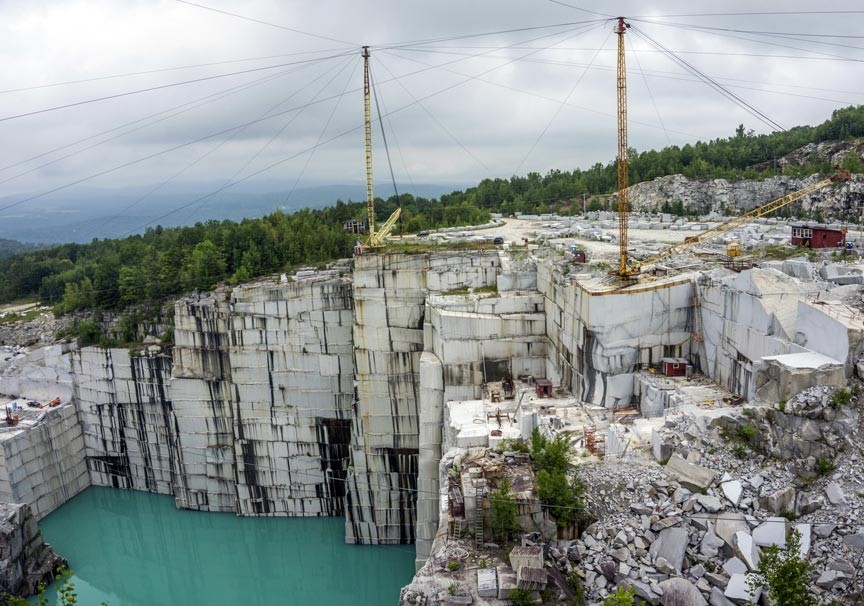Introducing the Mysteries of Granite Quarrying: Where Toughness and Elegance Meet
The world of granite quarrying is a world where the raw strength of nature assembles with human artistry to develop structures that stand the examination of time with an air of style. From the depths of quarries to the meticulous polishing in workshops, the procedure of transforming granite into architectural wonders is a complex dance of practice and technology. As we peer right into the depths of this old craft, we start to uncover the covert ins and outs that form the very essence of our built setting.
The Origins of Granite Quarrying
In the record of building history, the origins of granite quarrying are shrouded in a tapestry of ancient workmanship and geological wonders. Dating back to ancient Egypt and Mesopotamia, the removal of granite from quarries noted the start of a trip that would ultimately cause the creation of several of the globe's most famous structures.
Granite quarrying's roots can be mapped to the proficient craftsmens that acknowledged the stone's longevity and visual appeal. With a combination of primitive devices and large decision, these very early quarry workers uncovered granite blocks that would certainly end up being the foundation of civilizations.
As people developed, so did the methods of quarrying granite. The Romans, renowned for their engineering prowess, created advanced techniques for removing granite to build monoliths, temples, and roads that stood the examination of time.
The legacy of these ancient quarrying techniques proceeds to form modern design, with granite remaining an icon of strength and sophistication in construction projects around the world. (granite quarries in south africa)
Tools of the Quarrying Trade
The evolution of granite quarrying techniques from ancient civilizations to contemporary times highlights the crucial role played by the devices of the quarrying sell forming the market's techniques. In ancient times, quarrying tools were rudimentary, usually containing chisels, hammers, and wedges made from products like bronze or iron. These devices needed substantial workforce and time to essence granite obstructs from quarries.

In addition, the introduction of pneumatically-driven devices and high-powered machinery has considerably reduced the physical labor needed in quarrying operations, improving employee safety and efficiency. As the quarrying sector remains to introduce, the devices of the profession continue to be at the leading edge of driving progression and forming the future of granite removal.
Drawing Out Blocks of Granite
Utilizing precision equipment and progressed strategies, the removal of granite blocks from quarries has ended up being an innovative procedure in the modern-day quarrying market. Regulated blowing up methods are then used to damage apart the granite into manageable areas.

Sprucing Up and Completing Strategies
To attain a perfect surface on granite blocks, experienced craftsmens employ a collection of careful sprucing up and completing strategies. After the initial extraction and forming procedures, the granite obstructs go through an extensive sprucing up phase to improve their natural appeal and longevity. One common approach used in polishing granite is ruby abrasion, where commercial diamonds are utilized to grind and brighten the rock to a smooth coating. This process not only creates a shiny surface area yet also guarantees uniformity in shade and appearance throughout the granite block.
In enhancement to sprucing up, finishing techniques are here are the findings used to more fine-tune the granite's look. These techniques may include flaming, refining, or cleaning, each offering one-of-a-kind textures and finishes to fit various visual choices. Flaming, for circumstances, entails exposing the granite surface to heats to produce a harsh, distinctive coating, perfect for exterior applications where slip-resistance is essential. Developing, on the other hand, offers a matte surface that is smooth to the touch, best for indoor counter tops and floor covering. By very carefully choosing and applying these polishing and completing methods, artisans can transform raw granite blocks right into exquisite pieces that display both toughness and style.

Ecological Influence and Sustainability
With the expanding focus on environmental awareness in the industry, granite quarrying methods are significantly inspected for their effect on natural sources and long-term sustainability. Quarrying for granite can have substantial environmental ramifications. The removal process typically entails the use of heavy equipment, explosives, and big quantities of water, bring about habitat damage, soil disintegration, and water contamination. In addition, the transport of granite from quarries to processing facilities produces carbon exhausts, further adding to environmental deterioration. granite quarries in south africa.
To mitigate these impacts and guarantee sustainability in granite quarrying, market stakeholders are embracing different procedures. Applying innovative technologies to reduce power intake and water use, recovering quarried land for environmental repair, and promoting accountable sourcing practices are some techniques being employed. Accreditations such as the Forest Stewardship Council (FSC) and the Management in Power and Environmental Style (LEED) help consumers recognize ecologically friendly granite products.
Verdict
To conclude, granite quarrying is a process that requires specialized tools and strategies to extract blocks of granite and brighten them to a high level of coating. While the browse around this site environmental influence of quarrying can be considerable, initiatives are being made to enhance sustainability techniques in the market. Overall, granite quarrying is a fragile balance in between utilizing the toughness and beauty of this all-natural stone while decreasing its effect on the setting.